



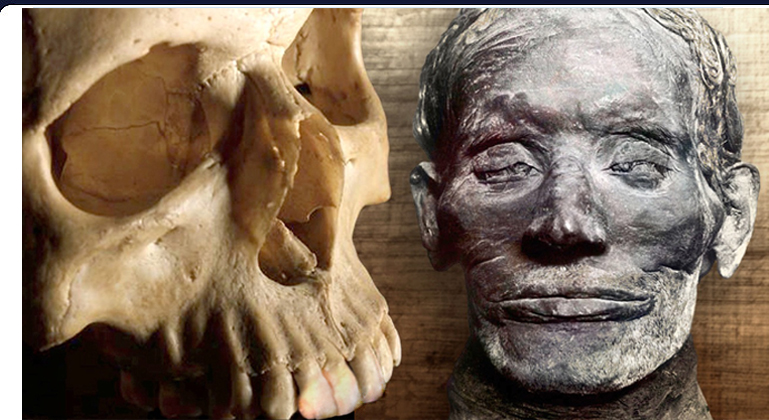
Resonance in Exoplanetary Hybridization
Exoplanetary Genetics of the Hybrid Dragon Kings
by Alex Putney for Human-Resonance.org
August 10, 2015
Royal dynastic bloodlines throughout the world claimed to be heaven sent, directly descended from the Gods. This intriguing claim can be easily tested: genetically. An opportunity just recently presented itself in the form of a large skull received in very poor condition on February 11, 2015 as a birthday gift from a friend residing in Riobamba, Ecuador (below). Several unusual features drew my attention immediately.
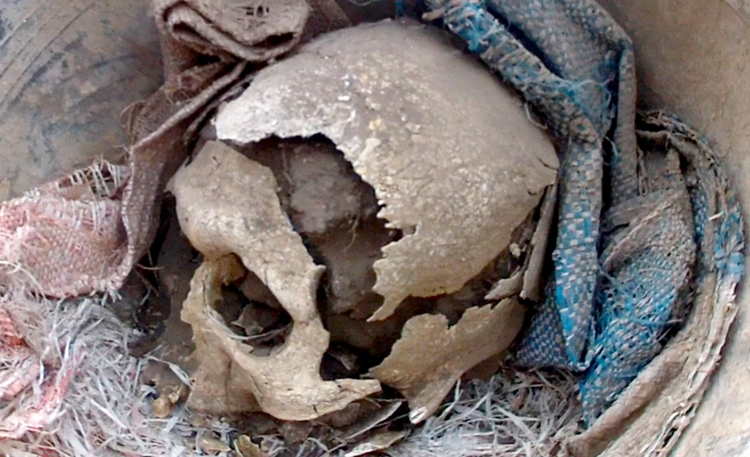
Seeking an expert opinion, I described the skull's size, anomalous molar root structures and provenance information in a June 29, 2015 message to world-renowned cryptogenomics expert Dr. Melba Ketchum:
After expressing great interest in the relic, I was given this fragile, fragmented skull by a friend living in Riobamba, Ecuador, who had excavated it many years prior. He showed me photographs of his excavations undertaken with local farmers in the high mountain community of Alacao, who had stumbled across scores of ceramic sherds on the property of his friends --the Meléndrez family-- and subsequently uncovered pre-Inka tombs.
A jewelry shop owner in nearby Guano tried to sell dozens of 18k gold artifacts from the site, which were spotted and confiscated by government authorities in 2005, and the seller jailed.
Government archeologists excavated a few tombs and identified the site at Alacao, Ecuador as a pre-Inka cemetery attributed to the Elenpata culture dating from 850-1,300 AD. When the government halted excavations and cordoned off the site, angry locals continued to loot the large cemetery, and are now melting down their plundered gold... a very sad situation.
Unfortunately, this ongoing standoff scenario between poor indigenous communities and government authorities is not unique, but actually reflects the status quo at hundreds of ancient cultural sites located throughout Ecuador, Colombia and Peru.
In light of these regrettable social and political circumstances surrounding the Alacao cemetery, and especially considering this skull's highly anomalous zygomatic and dental structures, I would like to submit an intact molar from this skull for complete genomic analyses.
As mentioned before, I suspect it's an oversized hybrid Inka king (perhaps standing ~6'6" in height), because all its molars have anomalous root structures. Each molar has root canals that are fused into a single root structure, looking somewhat like a large kernel of corn. I will take some quality detail photos of the odd molars asap.
This very prognathic skull also shows notable protrusions on the zygomatic bone that are consistent with the unusual features of giant skulls from Paracas, Peru. These protrusions apparently provide broader muscle attachment sites for powering the much heftier jaws of this newly recognized giant humanoid species.
The Alacao skull's large proportions and distinctive combination of unusual features directly implicates the presence of non-human nuDNA sequence that merits whole genome analysis. Forensic DNA expert Dr. Ketchum has graciously accepted a sample tooth (second molar, below) from the Alacao skull for inclusion in her broad survey of genetic material from giant humanoid specimens, entailing RC-14 dating, DNA extraction, next generation whole genome sequencing and relevant analyses, if feasible.
Cranial characteristics of these fragmentary remains from the Alacao cemetery correspond to a very large adult male standing between 6'6" and 7'0" (198-213cm) in height, displaying a very prognathic profile due to the significantly enlarged mandible. In addition, the notably enhanced occipital region of the skull presents enlarged mastoid processes that indicate a strong, thickly muscled neck and shoulders.
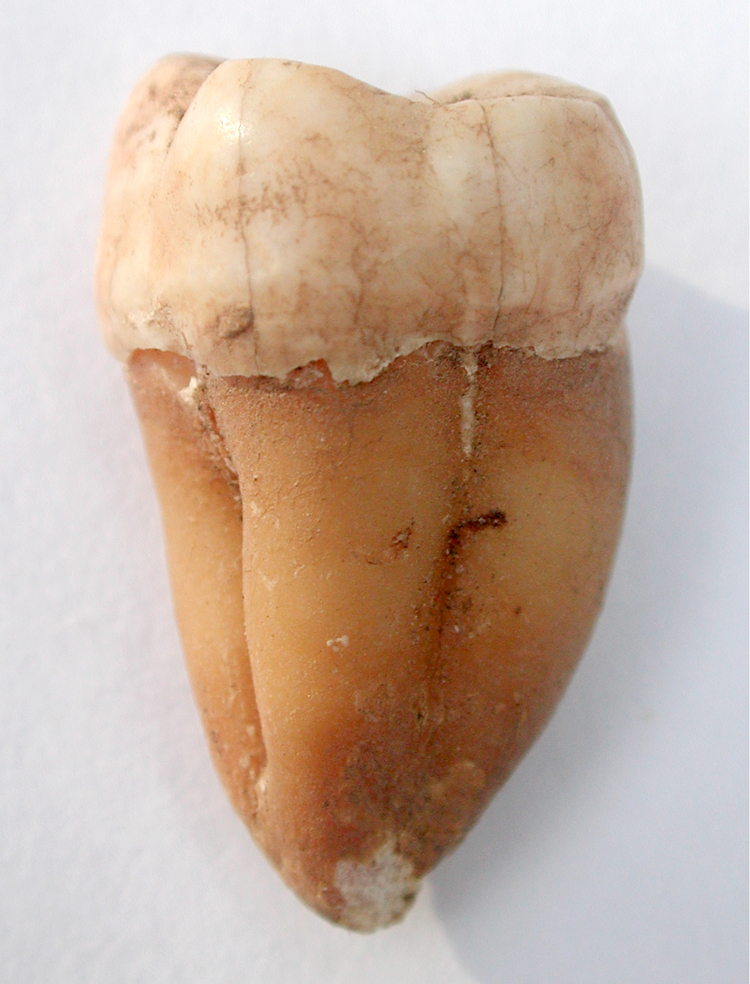
Distinctive enlarged brow ridges are seen at the juncture with the raised nasal bridge, indicating a very large nose. Hooked protrusions along the zygomatic bones (at the temples) and along the lower edge of the jawbone provide raised ridges offering greater surface area for heavier muscle attachment sites. The many outstanding features of the Alacao skull also include the enlarged incisive foramen --a dental roof feature that is typically larger in reptile species such as alligators and snakes.
If the Alacao skull's divergent morphological features arise from a non-pathological source, as a healthy expression of unknown genetic sequence, this skull represents an intelligent humanoid species that is completely new to science. We may be looking at an exotic human hybrid species following the unusual genetic configuration revealed in the ongoing Sasquatch Genome Project directed by Dr. Ketchum.
In the case of North American Sasquatch hair samples, distinctly non-human hairs consistently yield human mitochondrial genetic sequence. In the Ecuadorian case of the Alacao skull, distinctly non-human molar configurations might also yield human mitochondrial DNA sequence and non-human nuclear DNA.
Matrilineal genetic sequence of the Alacao skull, or mtDNA, most likely belongs to Aymara or Quechua haplogroups B or C, consistent with known human sequence from ancient indigenous groups of the high-altitude Andean regions of present-day Colombia, Ecuador, Peru, Bolivia and Chile (Shinoda et al., 2006).
Sequencing of nuDNA from the Alacao skull will likely reveal a novel mosaic pattern comprising novel sequences that are related to reptiles, interspersed with sequences that are closely homologous to humans. Phylogenetic alignment with reptiles is explicitly supported by several large earthenware statues from La Maná, Ecuador representing giant bipedal reptilian humanoids completely covered in scales.
This previously unidentified giant human hybrid species that lived among and was ceremonially entombed by ancient Andean peoples requires a scientific name corresponding to archeological and phylogenetic evidence. Whole genome sequencing of the Alacao skull will determine the worthiness of the tentative species name inferring reptilian genetics (from Latin: "of the dragon, serpent"): Homo sapiens draconis.
After DNA extraction of a sample molar tooth from the Alacao skull by Dr. Ketchum at DNA Diagnostics, double-blind studies will be conducted at several world-class laboratories in Texas to determine the specimen's whole genome. Until DNA results are obtained, the present work involves surveying the relevant yet suppressed archeological findings that solidly establish the hybrid species phenotype.
Months of careful research have enabled identification of the same peculiar set of cranial features seen in the Alacao skull among the skeletal remains from royal lineages of various ancient civilizations in Africa, Asia and the Americas. The distinctive signatures of a global mass hybridization period corresponding to the timeframe of ~3,300-3,060bp have emerged surrounding the cult worship of giant reptilian humanoids.
Worship of these reptilians was orchestrated by their downline on Earth: a genetically engineered human hybrid species that ruled over human populations throughout successive waves of 'dynastic' periods that claimed legitimacy by virtue of being "heaven-sent descendants of the Gods", "Demigods" or "God-Kings".
General size and morphological comparison with skeletal remains from various ancient civilizations indicates the pervasive presence of this distinct species of giant reptilian/human hybrid has not yet been scientifically identified due to strict controls surrounding investigations of ancient skeletal remains of dynastic families imposed by every government of the world. In fact, these genetic lines go 'offworld'.
Accurate sources of information on the vast and enigmatic subject of ancient extraterrestrial genetic manipulation of humanity are scarce, but fascinating in their implications. The clearest source of data on the topic was obtained through The Cassiopaean Experiment in superluminal communication with unified thought forms conducted by psychic medium Laura Knight-Jadczyk and her small research group.
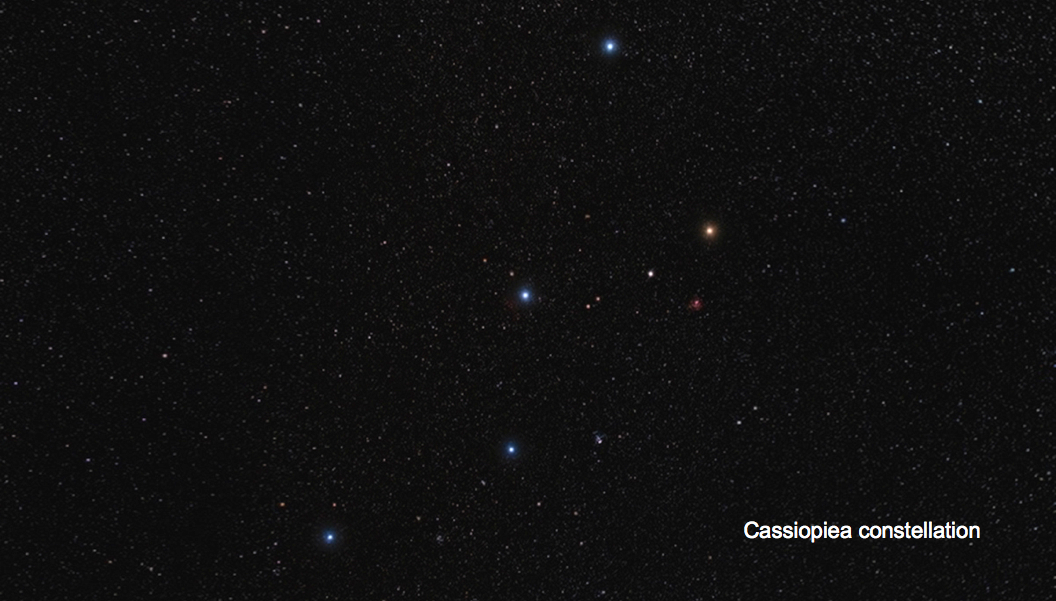
Transcripts of their earliest channeling sessions include several highly intriguing discourses concerning genetic manipulation by a giant reptilian humanoid species, comically referred to as the "Lizards". A basic question and answer protocol is used to transcribe ouija board replies, as recorded on October 20, 1994:
Q: Who built the city of Mohenjo-Daro?
A: Lizards directly. Coatzlmundi legend ties in to this directly look at illustrations on stones now.
Q: Who is Coatzlmundi?
A: Other deity of the Lizards worshipped by the Atlanteans and their descendants because of the direct contact with humans for 1000 years.
Q: Now, you said Mohenjo Daro was built by the Lizzies directly. Did they occupy this city themselves?
A: No.
Q: When was this city last inhabited continually?
A: 3065 years ago.
Q: When was it built?
A: 6092 years ago.
This interesting and fruitful line of inquiry was further pursued in the next session on October, 22 1994:
Q: (L) Did any aliens at all, and specifically the Lizzies, ever live among mankind and receive worship?
A: They did not live among mankind, but they did interact directly with human beings, at various points in the past. It was at those points when human beings were ready, willing and able to accept deities appearing directly from outside sources and then worship them. Such things would not have occurred in the recent past. But, beware, it may very well occur very soon...
Q: (L) Who built the city of Angkor Wat?
A: That was built by the Lizard Beings themselves. Built approximately 3108 years ago.
Q: (L) Who built the city of Mohenjo Daro?
A: That also was built by the Lizard Beings directly.
Q: (L) Did they live in these cities?
A: No, as stated before, they did not live there, they visited or occupied on a temporary basis, but did not live there.
Q: (L) Who did they build the cities for?
A: They built the cities for themselves and their worshippers amongst humans.
Ancient cult worship of giant reptilian humanoids visiting Earth from other planets and/or other dimensions of reality is a shocking possibility that most people would dismiss outright. However, any scientifically minded individual who comprehends the basic tenets of quantum physics must acknowledge the possibility as being not only feasible, but worthy of verification by direct archeological investigations.
Disparate references to reptilian humanoids were later identified in the Bible and the Edgar Cayce material during a short segment of conversation with the Cassiopaeans conducted on November 7, 1994:
Q: (L) Who was or is Baal [referenced in the Edgar Cayce trance readings]?
A: Lizard [Being].
Q: (L) [Who was] Beelzebub [referenced in the Bible]?
A: Same.
Q: (L) Were these actual names of individual Lizards?
A: No. Personifications.
So, there appear to be several famous historical references to the reptilian giants given under names that have been entirely removed from modern usage: Baal, Baalilal, Belial, Ba'al zebul, Beelzebub, Bezaleel, etc... Highly insightful details relating to the long-term intentions and sophisticated time-travel capabilities of the reptilian species emerged during a subsequent session with the Cassiopaeans on August 8, 1995:
Q: (L) Who was Arajuna of Tiahuanaco?
A: Well, we believe that you are referring to one of approximately eight hybrids that ruled the area currently referred to as Central America. Hybrids being a 4th density to 3rd density transfer experiment from the Lizard race to the human race, which was abandoned after approximately 240 years of experimentation by the Lizard Beings, due to the lack of success for sustaining physical duplication, or reproduction of the race. It was one of several attempts by the Lizard Beings to directly transmit their souls into 3rd density environment for permanent placement there.
Clarification on the physical appearance of the giant reptilian humanoids was given on December 19, 1998:
Q: Why do they look like Lizards?
A: They do not.
Q: Well, why do we call them Lizard Beings? I mean, you named them that?
A: We label in accordance with your familiarity. If we had called them "Drachomonoids," what would be your point of reference??
Q: What do they really look like?
A: You can figure as needed.
Q: You said they resemble upright alligators with humanoid features, six to eight feet tall...
A: Yes.
Hundreds of remarkably similar descriptions of giant extraterrestrial reptilian humanoids have been filed among innumerable UFO landing and alien abduction reports from eyewitnesses all over the world. Skulls from various Paleolithic sites strongly support the widely held claim that giant reptilian humanoids lived on Earth among human beings to receive worship, and indicate a likely timeframe from ~13,900-12,900bp.
From an archeogenetics perspective, this rational explanation for the anomalous characteristics of ancient elongated skulls is certainly worth investigating, especially considering the present status of strict government controls on genetic material from ancient dynastic cultures and associated sites.
If reptilian hybridization processes involve artificial insemination of human surrogate mothers for mid-term removal of the feti --as directly claimed by present-day victims of the alien abduction phenomenon-- novel reptilian genetic sequence would only be present in nuDNA, whereas the mtDNA would be fully human. Hybridizing an 8' tall (244cm) reptilian humanoid with a 5'4" tall (162cm) human would most likely produce a 6'8" tall (203cm) hybrid, representing a significant size enhancement that would be plainly evident.
Ancient patterns of cultural activity from the Paleolithic period bear the unmistakable traces of an otherworldly presence among human populations. While rock art specialists have documented dozens of petroglyphs associated with the worship of giant reptilian humanoids, distinctive linguistic and physiological references have not been recognized in their proper social context.
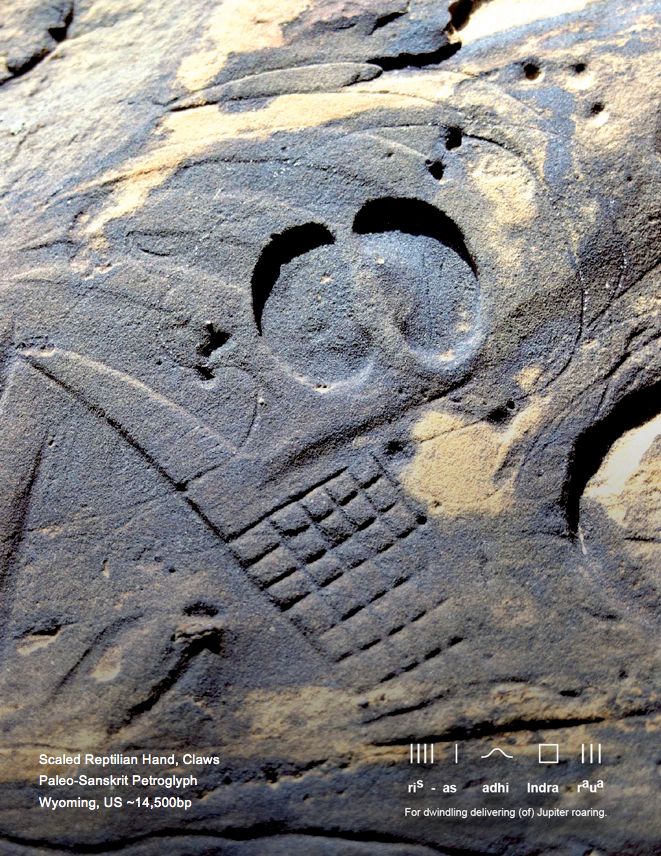
The most conspicuous example of the misinterpretation of ~14,500-year-old Paleo-Sanskrit petroglyphs involves a small wall panel engraved in yellow and grey sandstone in Western Wyoming. The main motif represents a large reptilian hand with an opposable thumb and long curving claws and a grid pattern inset along the wrist area (above). Despite having been inaccurately described as the forepaw of a bear, the whole petroglyph is composed as a hieroglyphic statement given in the Paleo-Sanskrit language.
The curved fingers of the hand present the Atlantean glyph ligature meaning "for dwindling delivering" and the grid pattern forms a ligature combination reading "Jupiter roaring". Altogether, the full statement reads: ris-as adhi Indra raua , meaning "For dwindling delivering (of) Jupiter roaring". The Indra grid motif is purposefully intended to replicate the scale patterns of reptilian skin, matching alligator scales (below).
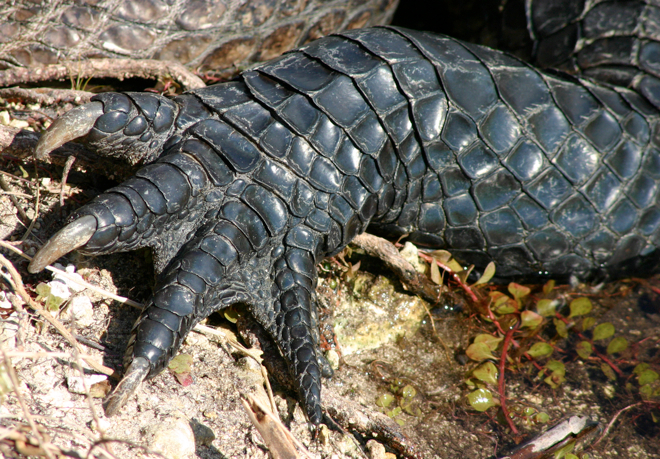
The Wyoming clawed hand petroglyph was subsequently defaced by a second, separate inscription made by a contemporary culture that openly rebuked the worship of reptilian giants by deeply engraving the feminine fertility symbol of their competing culture, represented by a hoofprint or animal track with the obvious double meaning as a vulva symbol. The culture of reptilian worship had been socially regected.
The reptilian grid pattern is recognizable as an Atlantean votive icon associated with the well-preserved skeletal remains of the giant extraterrestrial humanoids that had apparently lived and died among human populations in various regions of the Earth where this petroglyph can still be observed today. The most prominent site has been uncovered in the Southwest United States, along with related petroglyph sites.
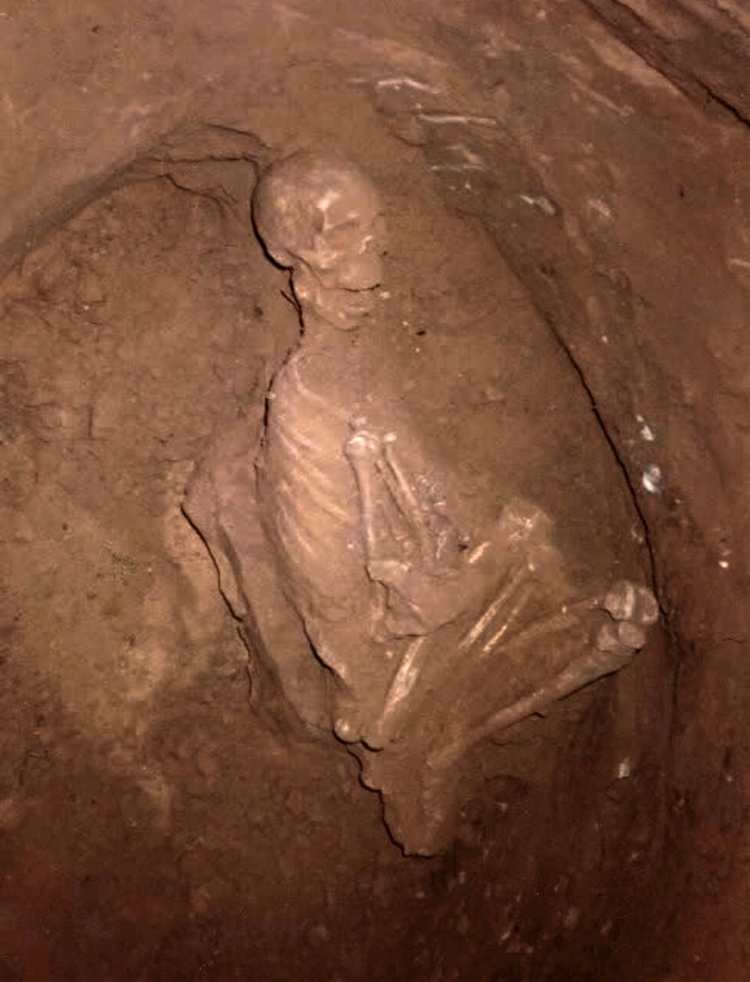
Giant humanoid skeletons were interred in oval burial pits within the sunlit chambers of an extensive tunnel system located in Johnson Canyon, Utah (37.13°N 112.38°W) that can be accessed from multiple entrances on privately owned land situated just east of the dusty town of Kanap. Genetic analyses of the giant skeletons conducted by university labs were suppressed due to decisively non-human test results. This work offers the first morphological descriptions of their distinctly non-human skeletal characteristics, definitively establishing the identity of this extant crypto-species by the scientific name: Homo draconis.
Precise measurement of the giant male humanoid skeleton revealed a full height of 8'9" (267cm, opposite). Even more astounding was the measured height of 9'2" (279cm) for the giant female humanoid skeleton (below). This size difference between the sexes is consistent with reptile species, wherein females typically outgrow males, contrary to male size-dominance observed in humans and other mammals.
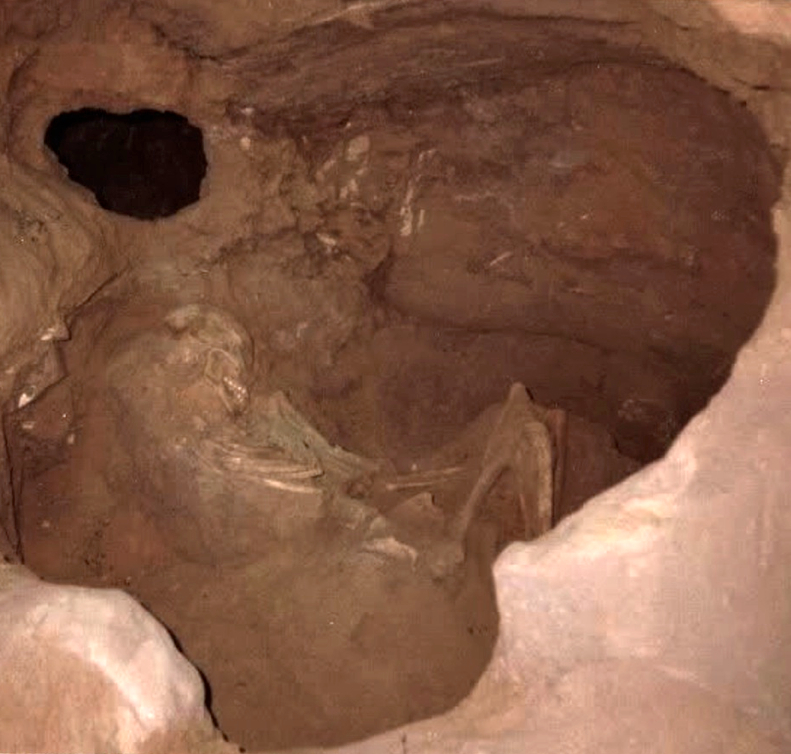
These giant reptilian humanoid skeletons display long torsos with thin ribcages and very narrow hips --even the female specimen posed in fetal position-- whose curved pelvic bones cannot be overlooked.
Comparison of the relative proportions of the giant, bulbous skull with the extremely narrow pelvis reveals the extend of the figure's non-human physiology: the front-to-back-length of the skull appears to exceed the width of the pelvis. What's more, the very angularly formed illiac crests of the pelvic bones terminate in sharp protrusions that represent another skeletal feature that is not characteristic of human anatomy.
The extreme elongation and slenderness of the entire skeletal frame is greatly contrasted by the robust features of the skull, face and mandibles that appear to be entirely out of proportion if human norms are considered. Measurements of the cranial dimensions and bone thickness, as well as DNA sampling for genomic analysis, were conducted by two major universities in the region. The results were suppressed.
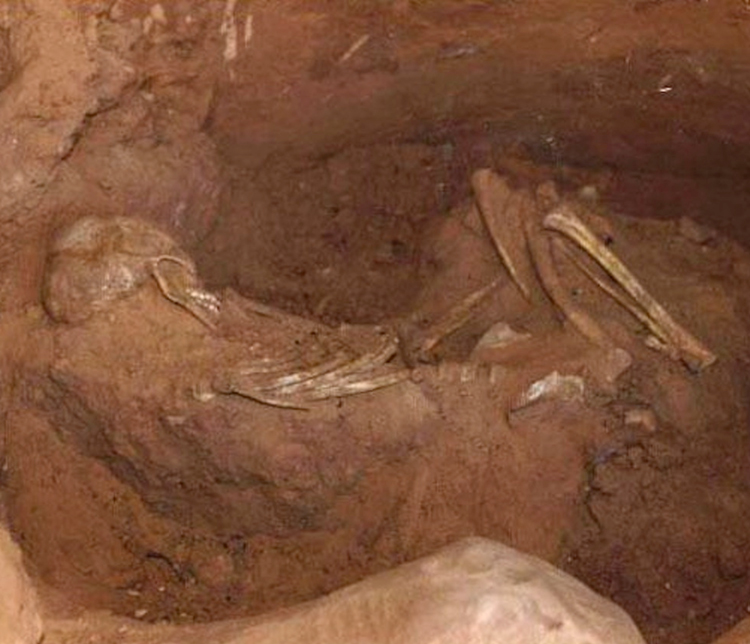
The full documentation and initial anatomical descriptions of multiple giant extraterrestrial skeletons offered here represent the first accurate scientific identification of the giant reptilian humanoid species in an archeological context, providing a comprehensive set of anatomical references that characterize the novel phenotype. While DNA analyses of the Johnson Cayon cave giants have been covertly controlled by government agencies, nuDNA sequence from the Alacao reptilian hybrid also defines the species.
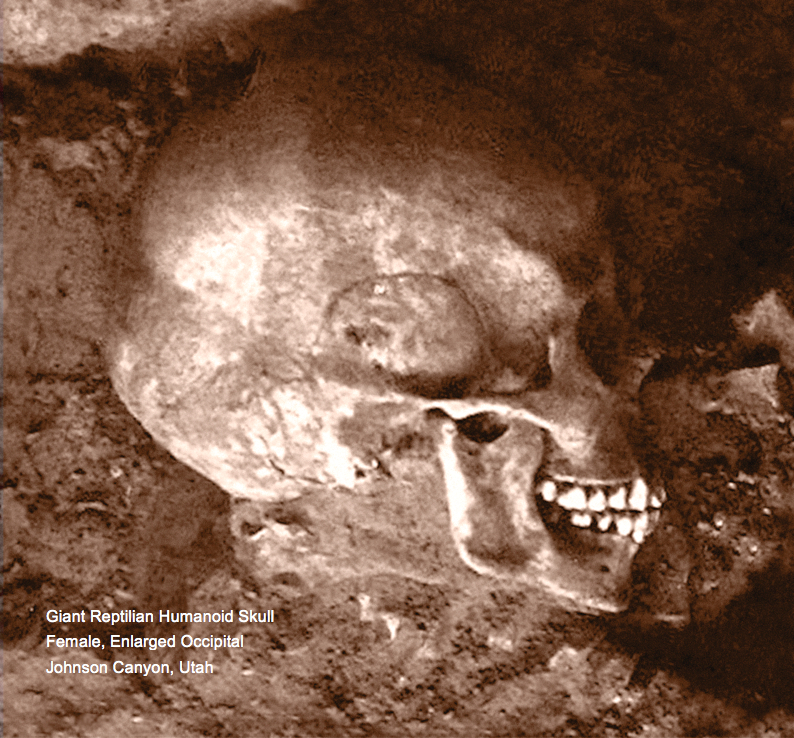
Close inspection reveals an unusual configuration of cranial plates, showing the complete absence of a suture separating the parietal bones, being entirely fused as one. Both of the giant skulls also possess an extremely large cranial capacity that has yet to be quantified, with the female specimen presenting a notable augmentation of the occipital region corresponding to enhanced infrasound reception.
Cranial enhancements were achieved by psychoacoustic helmets manufactured and used by Atlantean societies in subterranean complexes that were electrically powered and resonantly illuminated by focused infrasound standing waves transduced by the Great Pyramid of Giza, Egypt and received at full intensity in the nodal 'hotspot' located in Johnson Canyon, Utah due to its relative geoposition in the nonlinear network.
Johnson Canyon, Utah (37.13°N 112.38°W) is 7,247 miles from the Great Pyramid, a resonant distance comprising 29.11% of Earth's mean circumference of 24,892 miles, and approximating Fibonacci #358 in percent (29.38 x 10-73) and Fibonacci #135 in miles (7,308 x 10-24). These resonant distance calculations confirm the high-precision standing wave alignments underly the relative geopositions of the Great Pyramid and Johnson Canyon according to the mandala quantum function [ zn+1 = zn2 ].
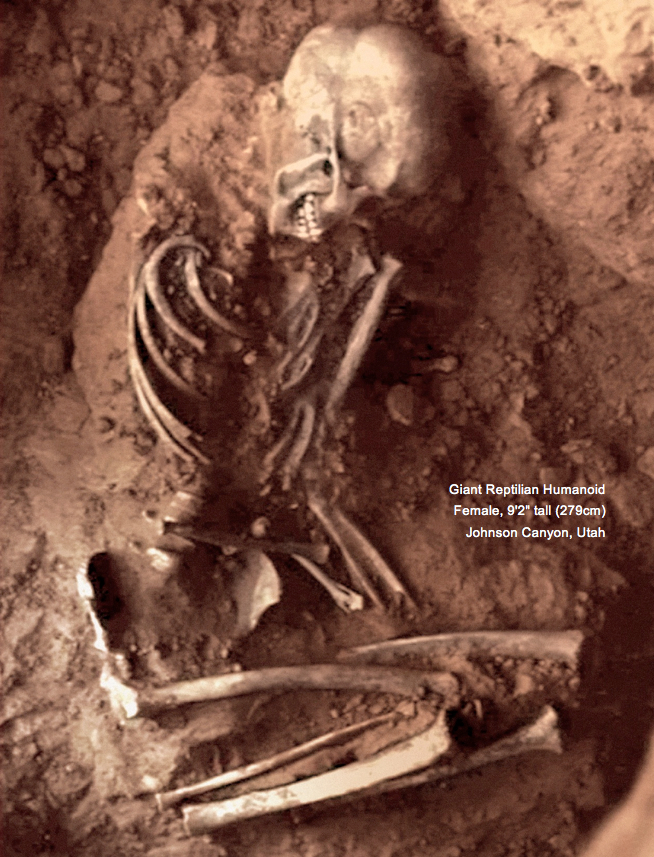
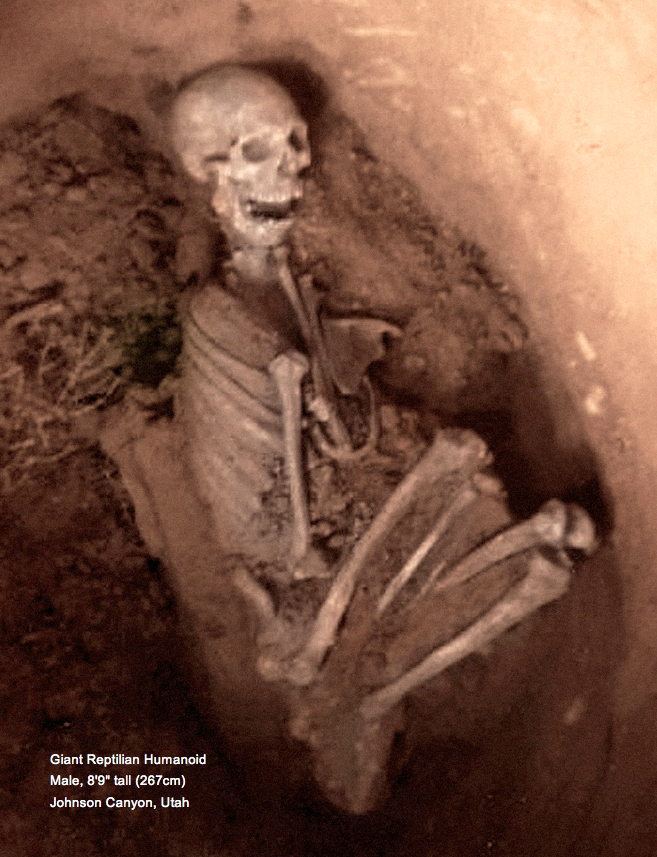
The giant reptilian skeletons were buried with giant garments and footwear woven from camelid hairs belonging to animals that went extinct in North America ~10,000 years ago. Paleolithic occupation at the Johnson Canyon cavesite is also indicated by the presence of multiple rock art panels engraved with hieroglyphic pictograms of the Paleo-Sanskrit language of the global Atlantean civilization (below).
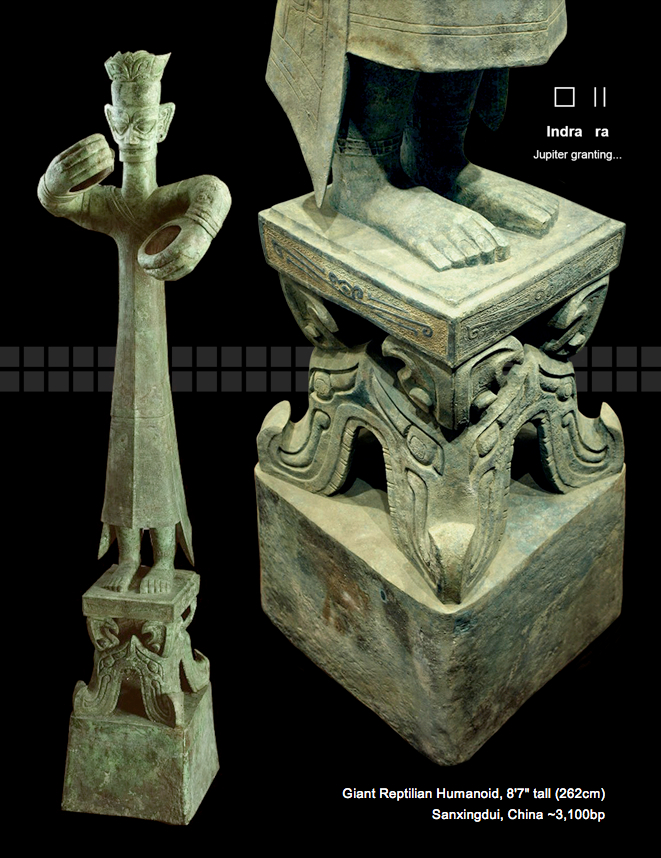
Repetition of the square Indra glyph in paired rows signifies Indra ra , or "Jupiter granting..." forming a grid pattern reminiscent of the scale patterns of reptilian skin. This grid ligature was also marked on ancient West African votive figurines and especially associated with China's dynastic icon: the dragon.
The archeological museum of Sanxingdui, China presents giant reptilian humanoids, including a life-size bronze figure with huge hands for holding an HHO plasma bulb of the same type depicted at Dendera, Egypt (below), both artworks having been cast during the very same timeframe ~3,100 years ago:
Its dragon robe, sun crown, and pedestal have suggested to many scholars that the figure is royal... a god, a priest-king, or even a god-king. Although no other large complete figures like this one have been found, fifty-seven similar heads (without bodies) were excavated. They are thought to have been mounted on poles, robed in cloth and arranged with this figure... [T]hese impressive figures could represent divine ancestor-kings... Their cult would have served to legitimize the heaven-derived lineage of the early Bronze Age kings of Sanxingdui.
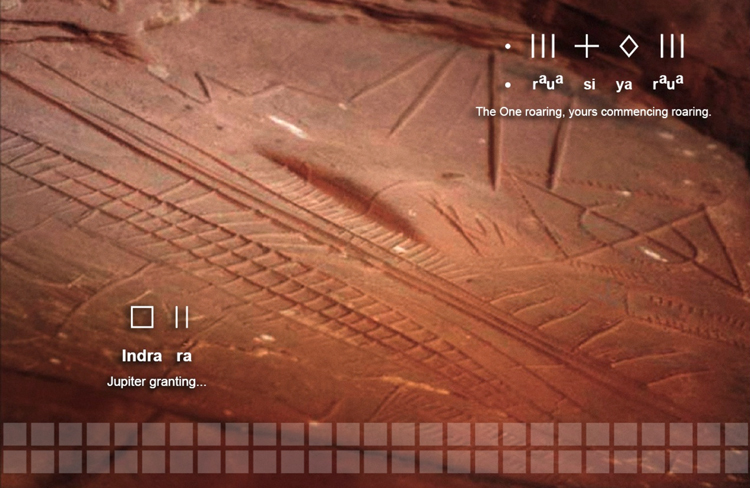
Including the base, this bronze reptilian humanoid statue stands 8'7" (262cm) tall --the same height as the giant reptilian skeletons of Johnson Canyon, Utah. Rows of squares on the anklets, the square pedestal and cubical base reiterate the phrase: Indra ra, meaning "Jupiter granting..." Trumpeting elephant heads forming the legs of the pedestal also reference the roaring of Indra; infrasound resonance from Jupiter.
Sanxingdui, China (30.993°N 104.200°E) is 4,275 miles from the Great Pyramid, a distance comprising 17.17% of Earth's mean circumference of 24,892 miles, and approximating Fibonacci #132 in percent (1725... x 10-24) and Fibonacci #354 in miles (4286... x 10-68). High-precision geopositioning along the 31st latitude enhances reception of infrasound standing waves focused at that resonant distance band.
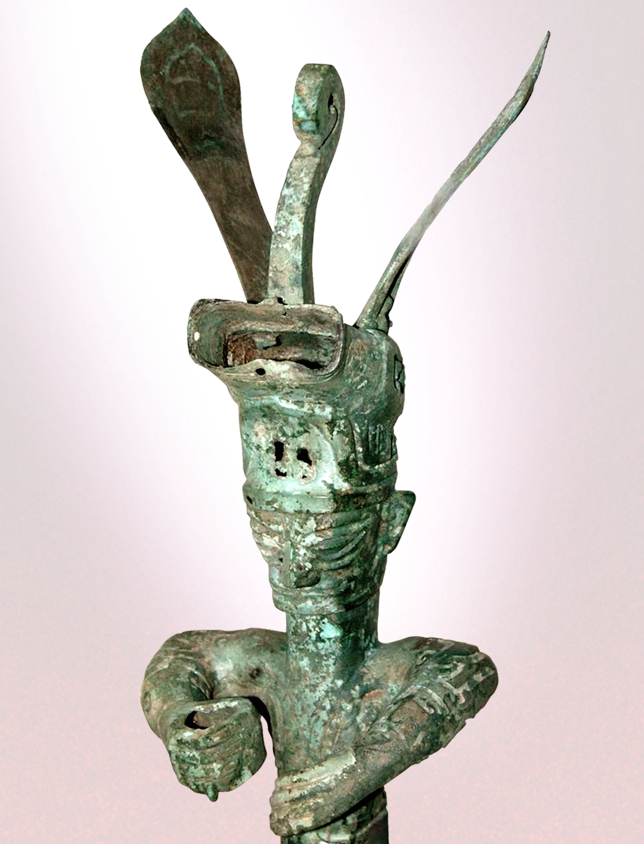
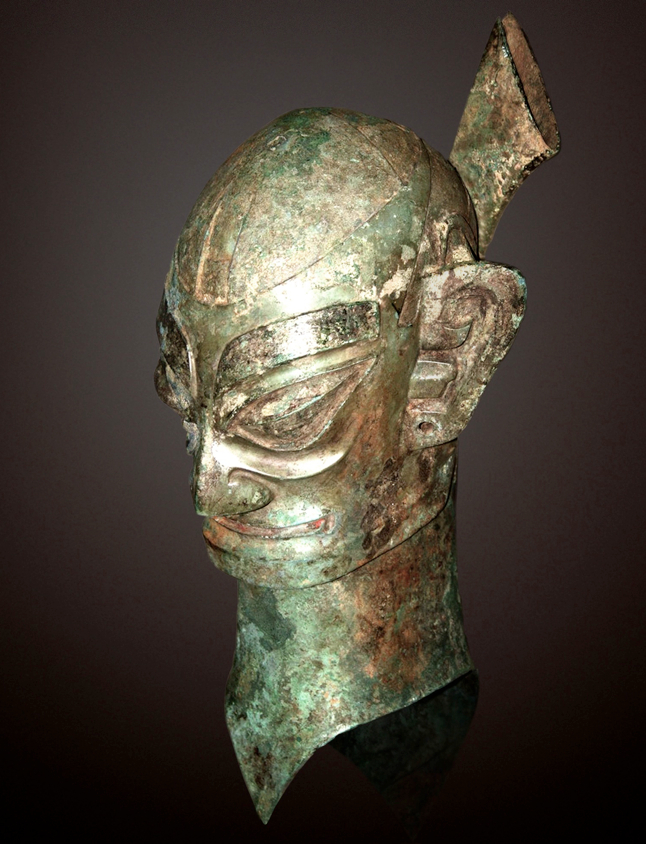
Of the 57 bronze reptilian heads from Sanxingdui, one wears a crown of entwined serpents representing coitus and the DNA double helix (below), symbolizing the reptilian species' advanced genetic engineering technologies. Reptilian manipulation of humanity is apparently done through mass hybridization projects, having artificially inseminated human surrogate mothers to create a ruling species of hybrid dragon kings.
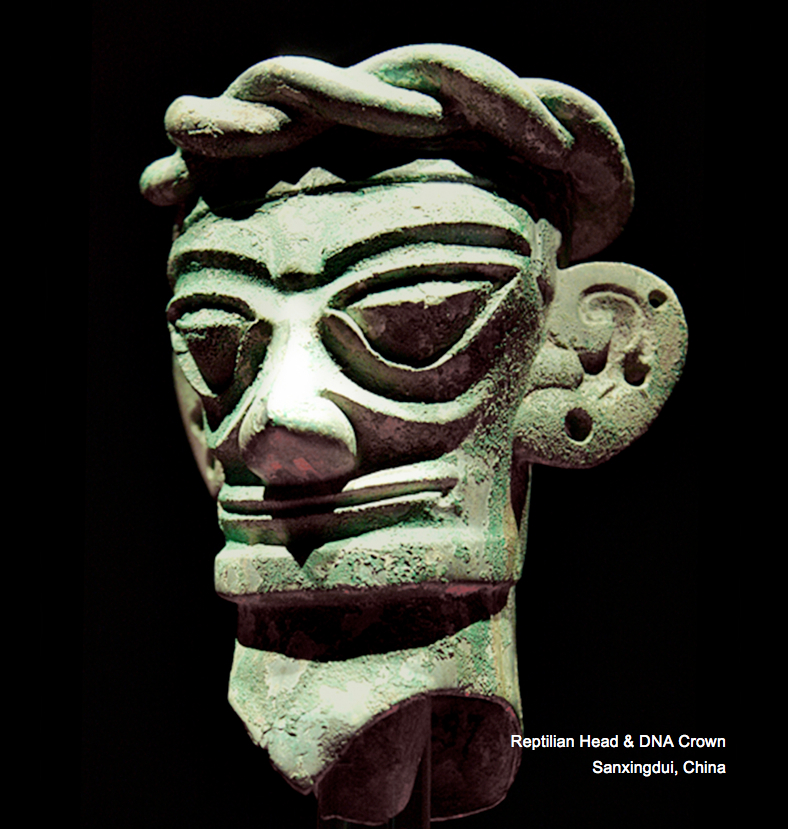
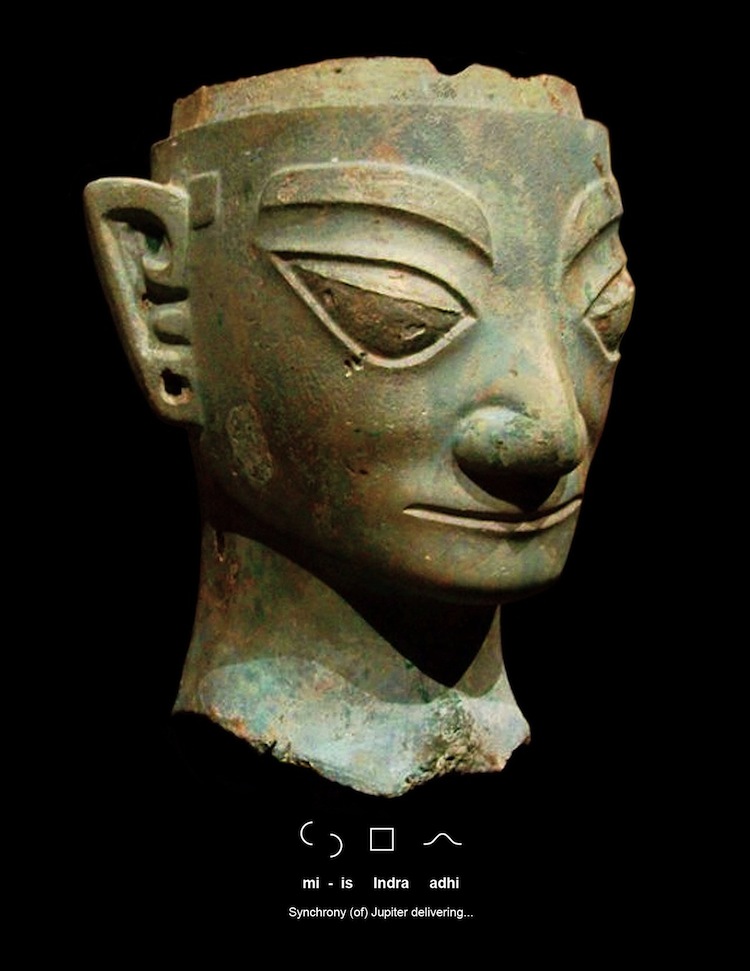
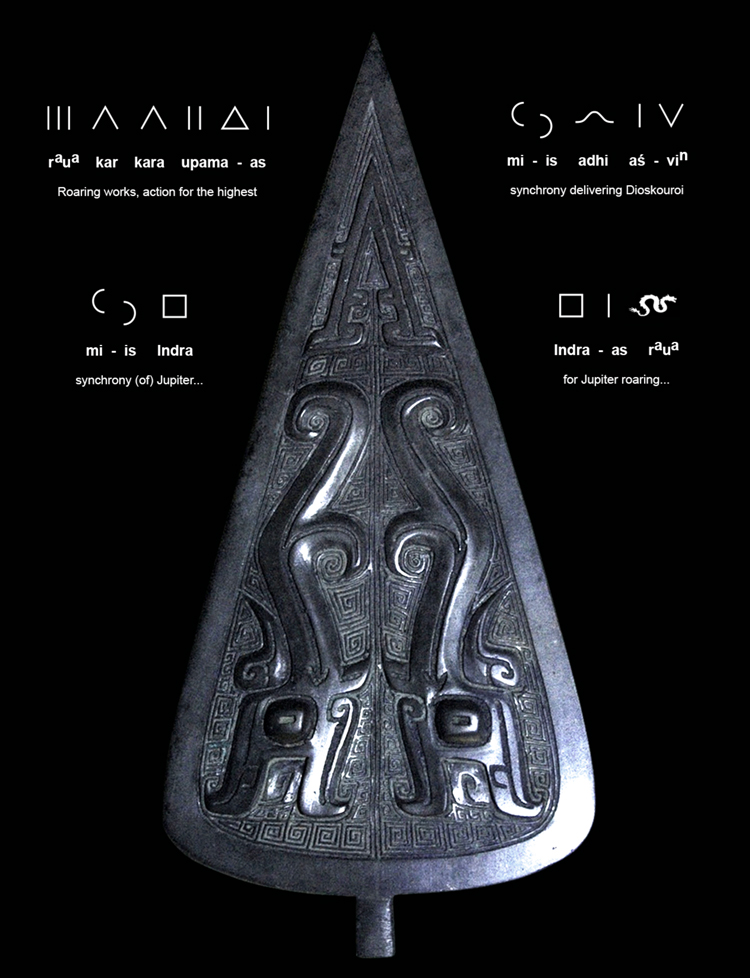
A ceremonial spearhead is covered in an hypnotically patterned composition of Sanskrit text with roaring dragons reading: raua kar kara upama-as mi-is Indra mi-is adhi as-vin Indra-as raua , meaning 'Roaring works, action for the highest synchrony (of) Jupiter..., synchrony delivering Dioskouroi for Jupiter roaring...' (above). A mesmerizing glyph-inscribed ceramic pot reads: mi-is upama-as vi mi-is Indra plava upama , meaning 'Synchrony (of) the highest, from synchrony (of) Jupiter inundating..., the highest...' (below).
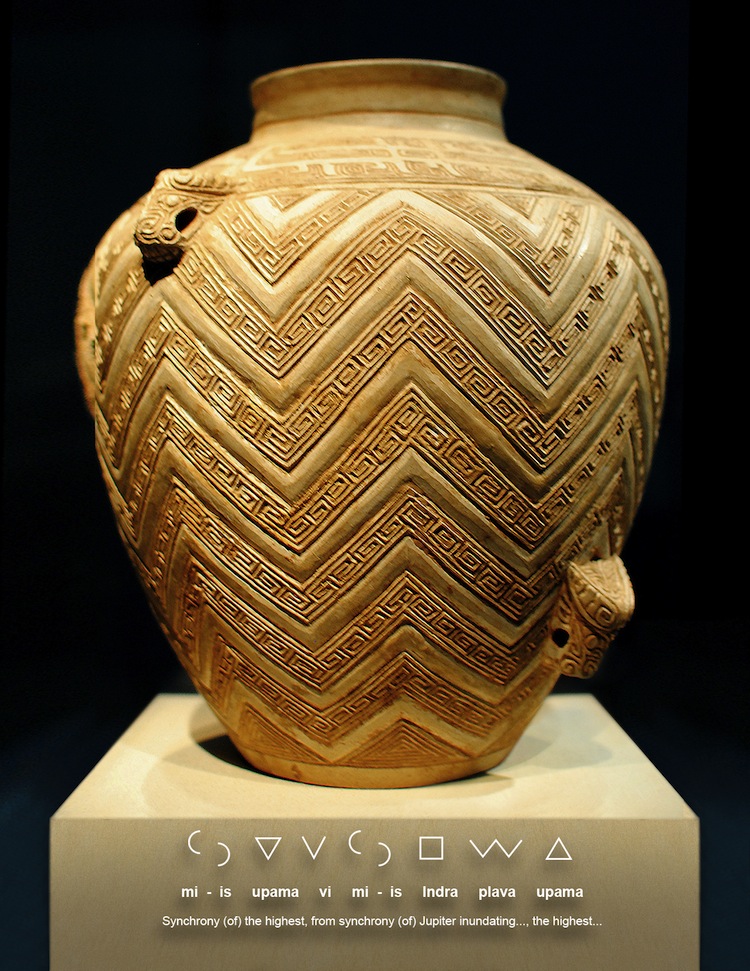
The stunning bronze representations of giant reptilian humanoids at Sanxingdui, China are emulated in architectural reliefs from a related site for worship of reptilian deities constructed at the very same time ~3,100 years ago. Giant smiling monumental faces form great towers overseeing the temple complex of Angkor Bayon, Cambodia (below), displaying the distinctive cranial characteristics of human/reptilian hybrids; very large, angled eyes, raised brow ridges, and extremely wide mouths covering square jaws.
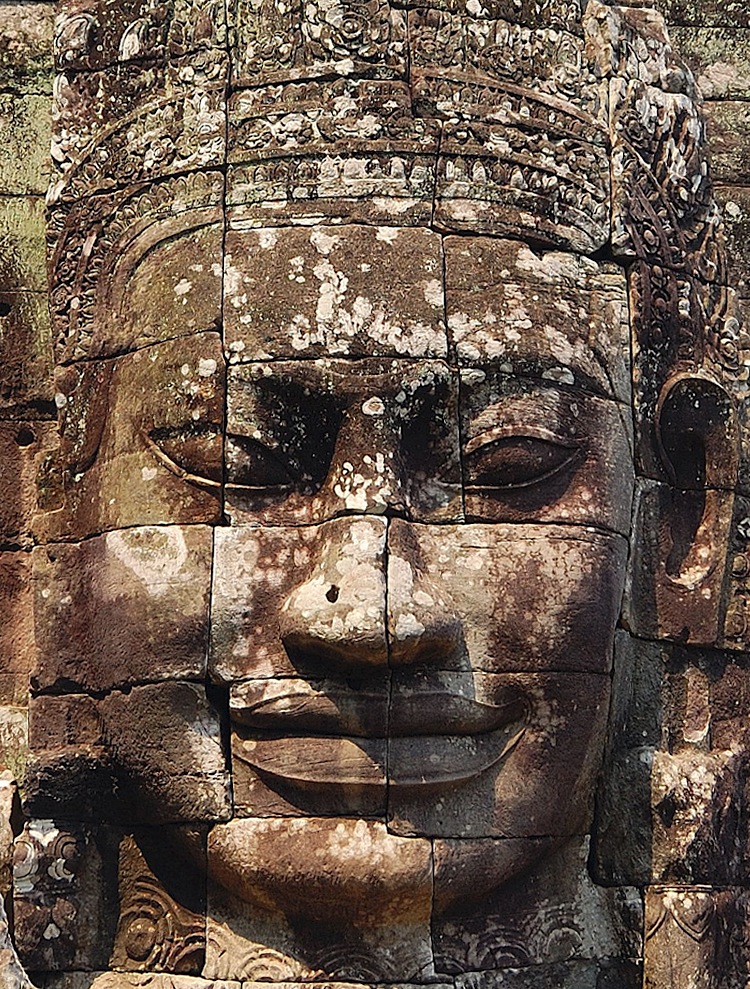
Government archeologists excavating the expansive Angkor complex have misattributed the construction period to more recent rulers of the Khmer Empire that occupied these magnificent temple palaces built by 'divine' ancestor kings millennia earlier, during a founding dynasty contemporary with the Hongshang dynasty at Sanxingdui and the Egyptian occupation at the Giza pyramids (also built much earlier).
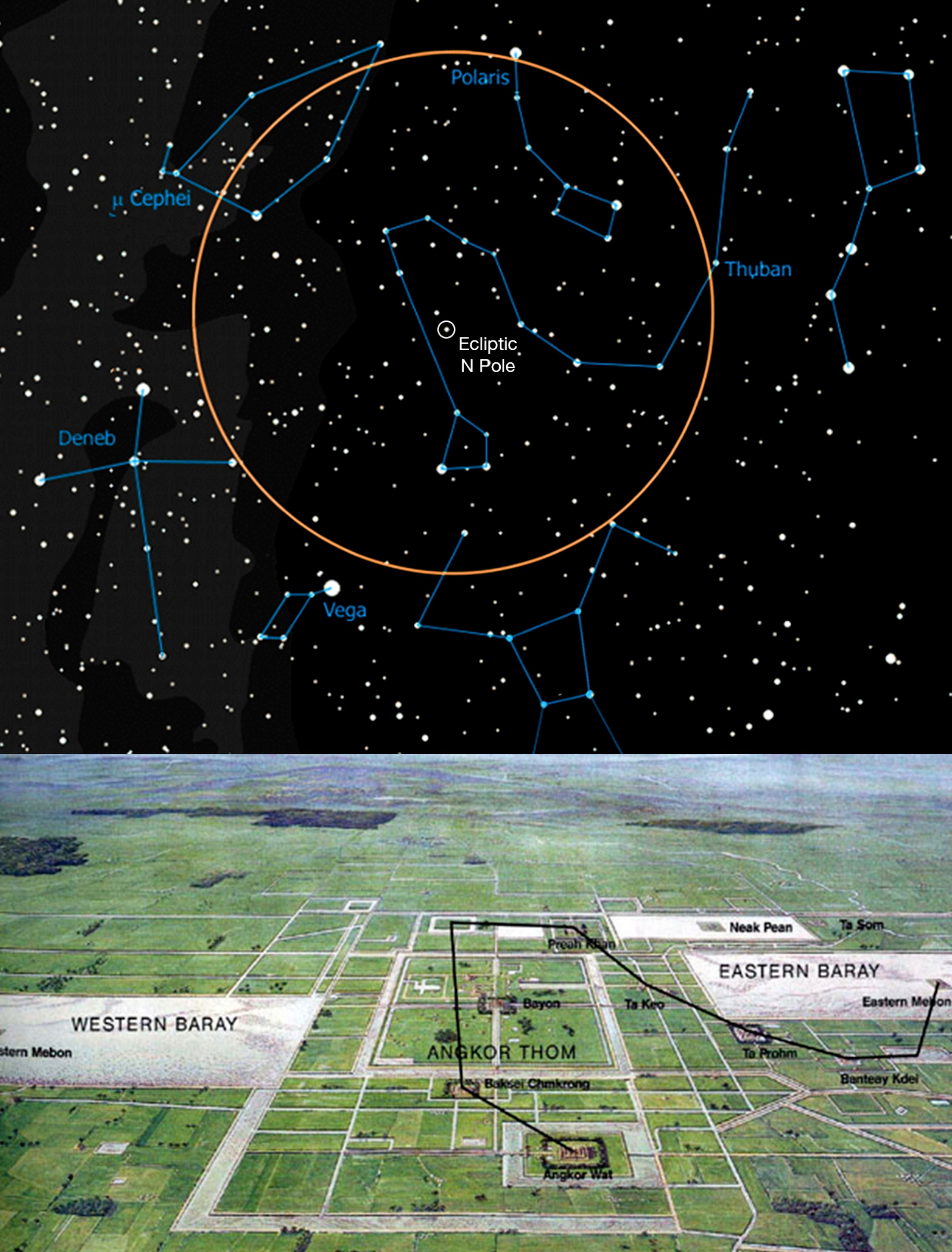
These piezoelectric stone monuments focus the divine universal force of infrasound resonance by high-precision geopositioning along natural axes of terrestrial standing waves. Tall psychoacoustic helmets manufactured from resonant alloys of gold were worn by the pharaohs and hybrid kings for biorhythmic synchronization, inducing neurogenesis and extraordinary cranial enhancements. These helmets were also worn by gold-clad hybrid females dancing in high relief wall panels at Angkor Wat (above).
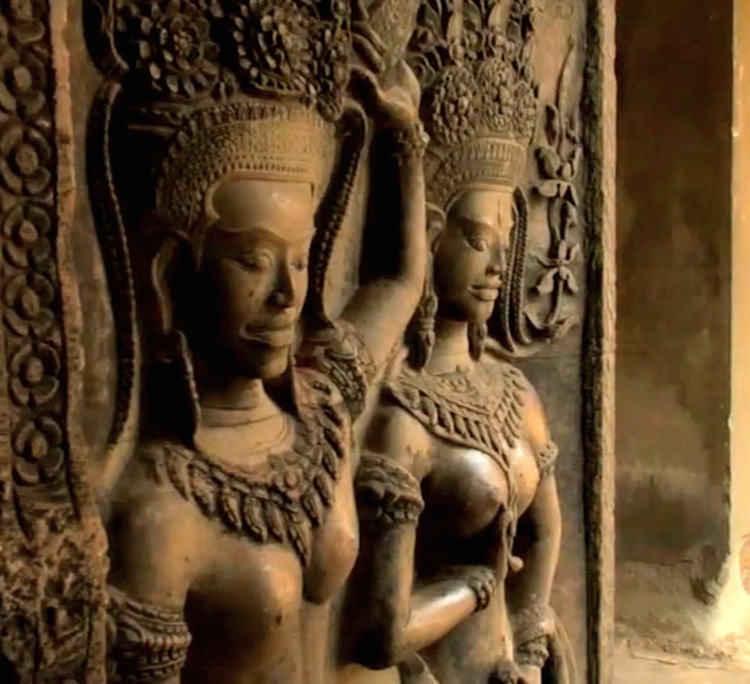
Rumbling infrasound resonance of the plasma giant Jupiter is efficiently transduced by piezoelectric stone temples geopositioned in Fibonacci alignment with the Great Pyramid, as defined by the quantum function [ zn+1 = zn2 ]. The Angkor complex (above) is 4,742 miles from Giza, corresponding to precisely 19.1% of Earth's mean circumference, matching F#359 in miles (4754... x 10-71) and F#137 in percent (191... x 10-27).
Legends disseminated among Asian Buddhist communities tell of ancient contacts with a foreign race of serpent beings, or 'naga' (Sanskrit for 'serpent'), who offered advanced teachings concerning astronomy, aeronautics and psychoacoustics --thereby generating the wise guru image of nagas popular throughout Asia today. The nagas are associated with the founding of Angkor, with temples designed according to the Mandelbrot Set [ zn+1 = zn2+ c ] and laid out in the star configuration of the cosmic serpent: Draco.
The Draco constellation contains 16 star systems with many planets, but not necessarily the homeworlds of the giant reptilian humanoids. However, the Reticulum constellation has been specifically referenced as containing homeworlds of the reptilian giants, by sources that identified multiple inhabited planets in Zeta Reticuli, which consists of two sun-like companion stars that form a wide binary star system (below):
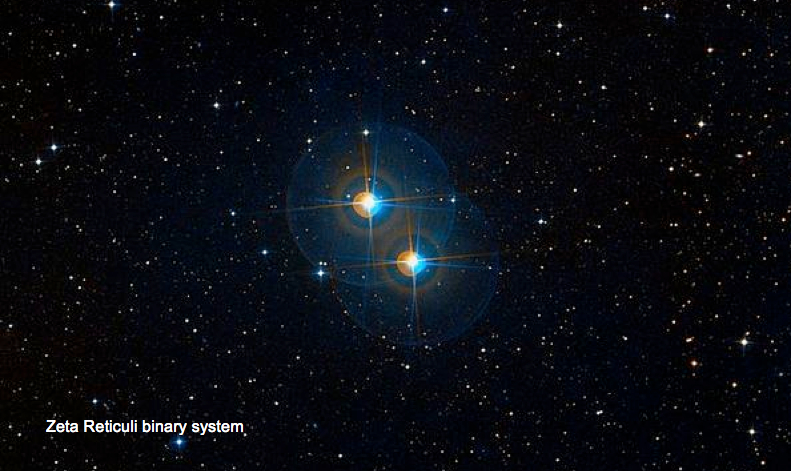
The distance between the two stars is at least 3,750 AU, so their orbital period is 170,000 years or more. Both stars share similar physical characteristics to the Sun, so they are considered solar analogs... Zeta1 has 96% of the Sun's mass and 84% of the Sun's radius. Zeta2 is slightly larger and more luminous than Zeta1, with 99% of the Sun's mass and 88% of the Sun's radius.
Astronomical data published in the Extra Solar Planets Encyclopedia on September 20, 1996 announcing the discovery of a large planetary body in close orbit of Zeta2 Reticuli made headlines before suppression by academia, as the findings partly confirmed the 1961 alien abduction report of Betty and Barney Hill.
Akashic information from the Cassiopaea Experiment specifically designated Zeta1 Reticuli as harboring 7 planets, including Earth-like worlds inhabited by a technologically advanced civilization. One of these 7 planets was later identified as 'Qaddeera' --named as one of the homeworlds of the giant reptilian humanoid species. While the data cannot presently be verified, a considerable amount of archeological evidence here on Earth explicitly confirms the reality of exoplanetary hybridization projects.
Continue to Archeological Traces
Return to Interspeciation
From the book Baal Hybrids
Copyright 2015 Alexander Putney